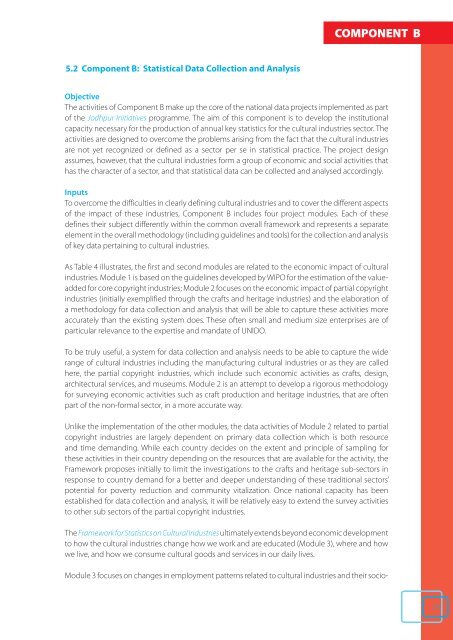Statistics on Cultural Industries - International Trade Centre
Statistics on Cultural Industries - International Trade Centre
Statistics on Cultural Industries - International Trade Centre
- No tags were found...
Create successful ePaper yourself
Turn your PDF publications into a flip-book with our unique Google optimized e-Paper software.
COMPONENT B5.2 Comp<strong>on</strong>ent B: Statistical Data Collecti<strong>on</strong> and AnalysisObjectiveThe activities of Comp<strong>on</strong>ent B make up the core of the nati<strong>on</strong>al data projects implemented as partof the Jodhpur Initiatives programme. The aim of this comp<strong>on</strong>ent is to develop the instituti<strong>on</strong>alcapacity necessary for the producti<strong>on</strong> of annual key statistics for the cultural industries sector. Theactivities are designed to overcome the problems arising from the fact that the cultural industriesare not yet recognized or defined as a sector per se in statistical practice. The project designassumes, however, that the cultural industries form a group of ec<strong>on</strong>omic and social activities thathas the character of a sector, and that statistical data can be collected and analysed accordingly.InputsTo overcome the difficulties in clearly defining cultural industries and to cover the different aspectsof the impact of these industries, Comp<strong>on</strong>ent B includes four project modules. Each of thesedefines their subject differently within the comm<strong>on</strong> overall framework and represents a separateelement in the overall methodology (including guidelines and tools) for the collecti<strong>on</strong> and analysisof key data pertaining to cultural industries.As Table 4 illustrates, the first and sec<strong>on</strong>d modules are related to the ec<strong>on</strong>omic impact of culturalindustries. Module 1 is based <strong>on</strong> the guidelines developed by WIPO for the estimati<strong>on</strong> of the valueaddedfor core copyright industries; Module 2 focuses <strong>on</strong> the ec<strong>on</strong>omic impact of partial copyrightindustries (initially exemplified through the crafts and heritage industries) and the elaborati<strong>on</strong> ofa methodology for data collecti<strong>on</strong> and analysis that will be able to capture these activities moreaccurately than the existing system does. These often small and medium size enterprises are ofparticular relevance to the expertise and mandate of UNIDO.To be truly useful, a system for data collecti<strong>on</strong> and analysis needs to be able to capture the widerange of cultural industries including the manufacturing cultural industries or as they are calledhere, the partial copyright industries, which include such ec<strong>on</strong>omic activities as crafts, design,architectural services, and museums. Module 2 is an attempt to develop a rigorous methodologyfor surveying ec<strong>on</strong>omic activities such as craft producti<strong>on</strong> and heritage industries, that are oftenpart of the n<strong>on</strong>-formal sector, in a more accurate way.Unlike the implementati<strong>on</strong> of the other modules, the data activities of Module 2 related to partialcopyright industries are largely dependent <strong>on</strong> primary data collecti<strong>on</strong> which is both resourceand time demanding. While each country decides <strong>on</strong> the extent and principle of sampling forthese activities in their country depending <strong>on</strong> the resources that are available for the activity, theFramework proposes initially to limit the investigati<strong>on</strong>s to the crafts and heritage sub-sectors inresp<strong>on</strong>se to country demand for a better and deeper understanding of these traditi<strong>on</strong>al sectors’potential for poverty reducti<strong>on</strong> and community vitalizati<strong>on</strong>. Once nati<strong>on</strong>al capacity has beenestablished for data collecti<strong>on</strong> and analysis, it will be relatively easy to extend the survey activitiesto other sub sectors of the partial copyright industries.The Framework for <str<strong>on</strong>g>Statistics</str<strong>on</strong>g> <strong>on</strong> <strong>Cultural</strong> <strong>Industries</strong> ultimately extends bey<strong>on</strong>d ec<strong>on</strong>omic developmentto how the cultural industries change how we work and are educated (Module 3), where and howwe live, and how we c<strong>on</strong>sume cultural goods and services in our daily lives.Module 3 focuses <strong>on</strong> changes in employment patterns related to cultural industries and their socio-25
















